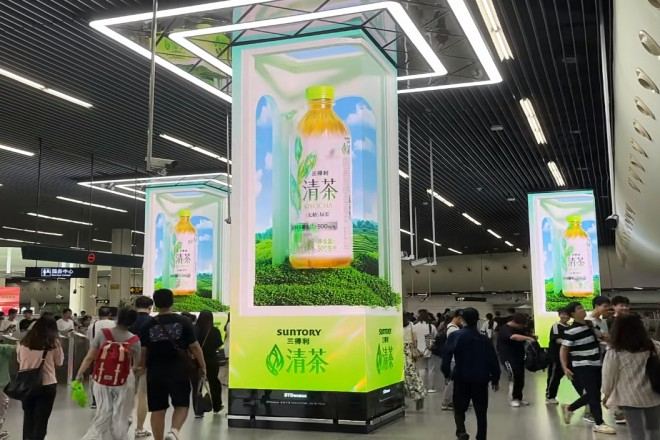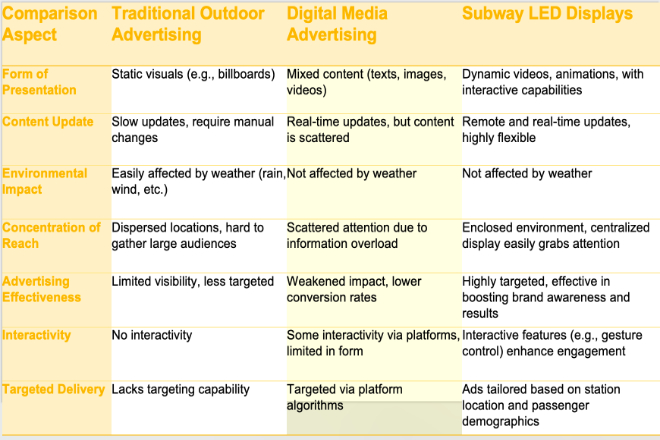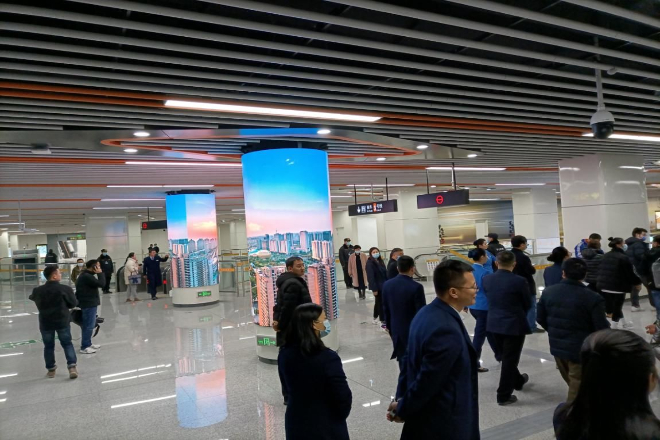مقدمة
How many people have noticed that those shining big screens are quietly leading the new trend in the advertising world?
In this era of information explosion, why have subway station يعرض الصمام become the “golden position” that advertisers are scrambling to seize?
It is not just a screen but also a smart medium connecting brands and consumers. This article will reveal why it is so popular.
جدول المحتويات
1. Analysis of the basic characteristics of subway station LED displays
1). Visual presentation advantages
Imagine that you see an advertisement showing a tropical beach in a subway station. The colors of the sun, beach, and seawater are so bright that they seem to take you there.
This is credited to the high definition and color saturation of the subway station LED display.
It can make the details in the advertising picture clear, and the colors are particularly realistic, just like the real objects you see with your own eyes, which can easily attract the attention of passengers.
Compared with static posters posted on the wall, subway station LED displays can play videos and animations.
For example, in a beverage advertisement, the screen can not only display the picture of the beverage but also play the process of the beverage being taken out of the refrigerator and even have the effect of ice cubes shaking in the beverage.
This dynamic picture can catch the passengers’ eyes better than static posters, making the advertising content more vivid and attractive.
The lighting in the subway station is relatively complex, sometimes very bright and sometimes a little dark.
However, there is no need to worry about this problem with the LED display, which has high سطوع and strong contrast.
Just like you can still clearly see the content on the outdoor billboards in sunny weather, the LED display in the subway station can also allow passengers to see the information on it under various lighting conditions.
Moreover, its high contrast can make black blacker, white whiter, and colors look more vivid, just like watching a colorful movie, with a particularly good visual effect.
No matter where you stand in the subway station, you can clearly see the content on the LED display.
For example, if you are waiting for a train at the end of the platform, far from the display screen, or if you are standing on the other side of the platform, the information on the display screen can be fully presented in front of you, and you will not be unable to see it clearly due to the angle problem.
This wide زاوية الرؤية design makes information transmission more efficient.
2). Technical and functional features
Suppose a brand has just launched a new product; advertisers can quickly update the advertising content of the new product to the LED display screen in the subway station through the remote control system.
Usun chok om kopwe siwini ewe softwer won noum we fon, ekkewe chon afanafan ra tongeni chok mwokutukut non ewe ofes me ekkewe screen non ewe nenien subway repwe mwitir pwarata ekkewe minefoon ad.
Kopwe ereni ekkewe chon sai non fansoun me kopwe uwei minefoon porausen pisek non fansoun mwochomwoch.
Imagine that the LED display screen in the subway station is divided into several areas:
The upper part shows the arrival time of the train, the middle part plays advertisements, and the lower part scrolls to display the announcements in the station.
In this way, when passengers are waiting for the train, they can not only see the train information but also understand the content of the advertisements and know the various notifications in the station.
One screen can meet multiple needs, greatly improving the utilization rate of the screen.
There are many electronic devices in subway stations that will generate various electromagnetic interferences.
However, the LED display is like an “anti-interference shield” and can work stably in such a complex environment.
For example, even when the train enters the station, the surrounding electromagnetic interference is very large, and the content on the display will not flicker or freeze, ensuring that passengers can always see clear and accurate information.
The shapes and spaces of subway stations vary, but LED displays can be customized according to specific needs.
For example, some subway stations have narrow passages, so you can customize a slender display; some platforms have large spaces, so you can install an extra-large screen.
Just like a tailor customizes clothes according to your figure, LED displays can also customize the most suitable size and shape according to the characteristics of the subway station.
Generally speaking, the service life of LED displays can reach several years or even more than ten years.
This means that subway stations do not need to frequently replace display screens, reducing the cost and trouble of equipment updates.
Just like you buy a good quality TV and can use it for a long time, the LED display screens in subway stations can also serve passengers stably for a long time.
2. Audience analysis of subway stations

1). Huge passenger flow and high exposure rate
1.1). Data description:
Subway stations are one of the transportation hubs with the largest passenger flow in the city. Take the New York subway as an example. It has a passenger flow of more than 3.5 million people every day.
Imagine that so many people shuttle through the subway station every day, which undoubtedly provides a huge potential audience scale for advertising.
Another example is the Paris subway, which has 308 stations distributed in 16 lines, covering almost the entire city.
Whether it is office workers, tourists, or local residents, they cannot do it without the convenience of the subway, which allows advertisements in subway stations to reach people from all kinds of backgrounds.
1.2). Passenger commuting habits:
Most passengers take the subway to get off work or school every day, which means that they stay in subway stations for a long time and frequently. For example, in the London
Underground, passengers stay in the subway station for a period of time every day, whether waiting for the train or transferring.
This frequent stay provides a high exposure opportunity for advertising, allowing advertising information to reach the target audience multiple times. Just like in the New
York subway, passengers will see various advertisements in the subway station every day, and these advertisements will gradually penetrate into the hearts of the people through repeated display.
2). Diversity of audience and consumption potential
2.1). Age level:
The audience of subway stations covers people of all ages. In the Paris subway, you can see office workers rushing to work, students carrying school bags to school, and elderly people leisurely taking the subway to the park.
This diverse audience structure enables subway stations to meet the audience positioning needs of various advertisers.
Whether it is a fashion brand for young people or a health product for the elderly, you can find a suitable audience in the subway station.
2.2). Consumption capacity:
Take the New York subway as an example. Many passengers are urban white-collar workers. They usually have high consumption capacity and potential willingness to buy advertised products.
These people not only have high incomes but also have a high degree of attention and willingness to buy various new products such as fashion and technology.
For example, at some stations in the New York subway, advertisers often place advertisements for high-end brands to attract passengers with high consumption capacity.
3. Advertising effect and communication advantages of subway station LED display screens
1). Accurate positioning and targeted communication
1.1). Geographic location and audience attributes:
Imagine a subway station in Manhattan, New York, surrounded by high-rise buildings and financial companies.
The LED screens here will display some high-end financial product ads, such as investment and financial services or private banking ads. In some subway stations in
Brooklyn near art districts and creative studios, the advertising content will become some creative design software or art exhibition information.
This precise push based on geographic location and audience attributes allows ads to directly find the people who are most likely to be interested.
1.2). Time and scene association:
For example, during the morning rush hour, everyone is in a hurry to go to work. At this time, some breakfast food or coffee ads may appear on the advertising screen because, at this time, what people need most is something to quickly replenish energy.
At the evening rush hour, the ads may become information about restaurants or gyms because people may want to eat or exercise after getting off work.
This way of pushing ads based on time and scene makes the ads look more intimate and easier to accept.
2). Brand communication and image building
2.1). High-frequency exposure:
Every day, thousands of people enter and exit the subway station. When passengers are waiting for the train or transferring, they will always inadvertently see the ads on the LED screen.
Just like in the London Underground, those who take the subway to work every day will unknowingly remember some frequently appearing brand ads.
This high-frequency exposure is like repeating advertisements in people’s brains, which slowly makes people remember the brand.
2.2). Environmental integration and brand image shaping:
The subway station itself is a modern and technological place, and the cool effect of the LED display makes the brand look more upscale.
For example, in the Paris subway, those advertising screens with a strong sense of design will also give people a sense of fashion and high-end.
This is like putting a “technological” coat on the brand, giving people a better impression of the brand.
3). Creativity and interactivity
3.1). Diverse creative forms:
LED displays can play a variety of content, such as animations, videos, pictures, and even interactive games.
At some stations on the Tokyo subway, there are some small games on the advertising screens, and passengers can participate by scanning the code with their mobile phones and win small prizes.
This interesting form of advertising not only allows passengers to kill time while waiting for the train, but also makes them impressed by the advertising content.
3.2). Interactive experience:
The LED display screens in some subway stations can also interact with passengers. For example, in some subway stations in Paris, the advertising screens can recognize gestures, allowing passengers to switch advertising content with gestures.
This interactive experience is like playing a small game in the subway station, making passengers feel that advertising is no longer boring propaganda but an interesting experience.
4). High exposure and effective coverage
4.1). High exposure:
The subway station is one of the most lively places in the city, with many people coming and going every day.
The LED display screen is installed in the most conspicuous position, such as the platform and the lobby, and it is difficult for passengers not to notice it.
Just like in the New York subway, hundreds of thousands or even millions of people pass by every day, so the exposure rate of the advertising screen is naturally very high.
4.2). Effective coverage of target population:
The passengers of the subway are mainly office workers, students, and tourists. They all have certain consumption capacity and consumption needs.
For example, in the London subway, those white-collar workers who take the subway to work every day are the target population that many brands want to reach.
Through the subway advertising screen, brands can directly convey this information to the people who are most likely to buy their products.
In general, the advertising effect of the subway station LED display screen is really good.
It can not only accurately find the target audience but also make the advertisement interesting and effective through various creative and interactive methods.
4. Comparison of subway station LED display screens with other advertising media

1). Comparison with traditional outdoor advertising
1.1). Limitations of traditional outdoor advertising:
Traditional outdoor advertising is mostly “rigid,” such as roadside billboards, which have fixed content and are difficult to update. It may take a lot of time and manpower to replace posters.
Moreover, it is particularly susceptible to weather. Heavy rain or strong wind may tatter the billboards.
Moreover, the location of traditional outdoor advertising is relatively scattered, and it is difficult to attract a large number of people to subway stations.
1.2). Advantages of LED display screens:
The LED display screens in subway stations can play dynamic videos and animations with rich and colorful content and can also interact with passengers.
For example, at some stations of the Paris Metro, passengers can switch advertising content through gestures. It is not affected by the natural environment. Whether it is windy, rainy, or snowy outside, the screen can work normally.
Moreover, the content of the LED display screen can be updated remotely, and advertisers can adjust the advertising content at any time.
2). Comparison with digital media advertising
2.1). Dispersion of digital media advertising:
Internet advertising is everywhere, with various platforms and various information, and users are easily distracted.
For example, when you are browsing social media, advertisements, videos, and friends’ dynamics are mixed together, making it difficult to focus on a certain advertisement.
This dispersion greatly reduces the influence of advertisements, and users may be attracted by other information before they have time to see the content of the advertisement clearly.
2.2). Focus of subway station LED display screen:
The subway station is a relatively closed space. When passengers are waiting for the train or transferring, their attention is easily attracted by the LED display screen.
For example, in the London Underground, it is difficult for passengers not to notice those dynamic and colorful advertisements when waiting for the train on the platform.
Moreover, the advertising screens in subway stations usually push advertisements based on the geographical location of the station and the characteristics of the passengers.
For example, advertisements for high-end brands are pushed at stations close to commercial areas, and advertisements for educational products are pushed at stations close to schools.
This makes the advertisements more targeted and more effective.
In general, subway station LED display screens have outstanding performance in advertising effects and communication advantages.
It can not only accurately find the target audience but also make advertisements interesting and effective through various creative and interactive methods.
Compared with traditional outdoor advertising and digital media advertising, subway station LED display screens have more advantages in focus and interactivity and can better improve brand awareness and advertising conversion rate.
5. Advantages of operation and management of subway station LED display screens
1). Stable operating environment
1.1). Reliability of subway system:
The subway is the main artery of urban transportation, just like the New York subway. Thousands of people rely on it to travel every day. The subway has a stable operating time.
No matter whether it is windy or rainy, the subway is always there waiting for passengers.
This stable operating environment allows advertisers to not worry about interruptions in advertising display, just like displaying their products on a super stable stage.
1.2). Screen maintenance and technical support:
Professional teams maintain the LED display screens at subway stations. These teams are like “doctors” of the screens, regularly checking the health of the screens.
If there is a small problem with the screen, they can fix it quickly to ensure that the advertisements are always displayed in the best condition.
For example, the LED display screens at some subway stations are cleverly designed to facilitate quick operation by maintenance personnel so that advertisers do not have to worry about the advertisements “falling off the chain” due to screen failures.
2). Norms and management of advertising placement
2.1). Audit mechanism:
Advertisements at subway stations are not something that can be put on the screen casually. Every advertisement must undergo strict review, just like passing through a “security gate.”
This not only ensures that the advertising content is legal and compliant but also maintains the environment of the subway station so that passengers can see high-quality and valuable advertisements.
This review mechanism is like an “insurance” for both advertisers and passengers so that everyone can rest assured.
2.2). Delivery strategy and service:
Advertisers do not have to worry about being unfamiliar with the subway station. The professional advertising operation team will provide a full range of services.
They will give advertisers advice based on the location of the subway station and the characteristics of the passengers.
For example, in subway stations close to the financial district, advertisements for high-end financial products are recommended; in stations close to schools, advertisements for educational products are recommended.
This precise delivery strategy is like assigning a “navigator” to advertisers, making advertising more effective.
3). Efficiency of operation and management
3.1). Remote control and real-time update:
Advertisers do not need to go to the subway station in person to update the advertising content. They can update the advertisement anytime and anywhere through the remote control system.
For example, advertisers on the London Underground can update the advertising content with one click through their mobile phones or computers, just as convenient as updating software on their mobile phones.
This remote control and real-time update capability allows advertisers to respond flexibly to market changes and adjust advertising strategies in a timely manner.
3.2). Diverse display forms:
LED display screens can not only display pictures and texts, but also play videos, animations, and even interact with passengers.
For example, in the Paris Metro, some advertising screens can use QR codes or gesture recognition to allow passengers to participate in interactive games and win small prizes.
This diverse display form is like providing advertisers with a “treasure box”, making advertising more interesting and attractive.
3.3). Energy saving, environmental protection, and anti-interference ability:
LED display screens are not only environmentally friendly, but also durable. They are not afraid of electromagnetic interference in subway stations, just like wearing a “bulletproof vest”.
This energy-saving, environmental protection and anti-interference characteristics not only reduce operating costs, but also ensure the stability of advertising display, so that advertisers do not have to worry about advertising being “interfered”.
In general, the operation and management of subway station LED display screens is like a well-designed “advertising ecosystem”.
It is stable, standardized, efficient, and can be flexibly adjusted according to the needs of advertisers.
This advantage makes subway station LED display screens the “darling” of advertisers, which can not only attract the attention of passengers, but also enhance the effectiveness of advertising and brand influence.
6. Future development trends and innovations of subway station LED display screens

1) اتجاه الابتكار التكنولوجي
1.1). Higher دقة and improved display effect:
Imagine that the LED display screens in subway stations in the future may be as clear as watching high-definition movies at home.
Ultra-high-definition display technologies such as 8K and 16K, which sound very powerful, maybe popularized in subway stations in the future.
For example, transparent OLED displays have been used in some subway stations. They can not only display subway lines and surrounding information but also allow passengers to see the scenery outside.
If this technology is used in advertising, the advertising effect will definitely be eye-catching.
1.2). Integration of interactive technology and augmented reality (AR):
In the future, LED displays in subway stations may become more “smart,” not only displaying content but also interacting with passengers.
For example, passengers can scan the screen with their mobile phones or switch advertising content through gestures.
Even through AR technology, the screen can present a virtual scene, making passengers feel as if they are in it.
This interactive and immersive experience can not only increase the fun of passengers but also make advertisements more attractive.
2). Market expansion and innovation of cooperation model
2.1). Cross-industry cooperation:
In the future, subway station LED display screens may “join hands” with more industries. For example, they may cooperate with industries such as culture, entertainment, and tourism to launch more creative advertising content.
Just like in Shanghai subway stations, art works are displayed through LED display screens, turning subway stations into “mobile art galleries”.
This cross-industry cooperation can not only expand the form of advertising, but also attract audiences from different fields, making the advertising content more colorful.
2.2). Data-driven precision marketing:
With the development of big data technology, subway station LED display screens will become more “smart.”
By analyzing passengers’ travel habits, consumption preferences, and other information, advertisers can accurately push advertisements.
For example, if the system finds that a passenger often takes the subway during a certain time period and often goes to a certain business district, then the preferential information of this business district can be pushed during this time period.
This kind of precision marketing can not only improve the conversion rate of advertising but also allow passengers to see advertisements that better meet their needs.
7. الخاتمة
With its powerful display capabilities, accurate communication effects and flexible operational advantages, subway station LED display screens have become the “traffic leader” of modern advertising.
In the wave of continuous technological evolution in the future, it will continue to refresh the new imagination of urban advertising and become an important battlefield for brand communication.
أخيرًا، إذا كنت تريد معرفة المزيد عن شاشات LED، يرجى الحصول على اتصال معنا.
